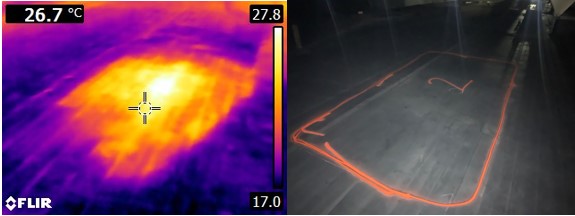An infrared roof moisture survey is a non-destructive diagnostic technique used to identify and evaluate moisture within a building’s roofing materials. This process utilizes the principles of infrared thermography, where an infrared camera is used to detect and measure the thermal energy (heat) emitted from an object or surface.
Here’s how it works:
- Thermal Differences: During the day, the sun heats the roof and its underlying materials. Moist areas within the roofing system—due to their higher thermal mass—retain heat longer than dry areas. After sunset, as the roof cools, these moist areas remain warmer compared to the dry areas.
- Infrared Camera: An infrared camera is used to capture images of the roof. These cameras can detect the heat radiated from various surfaces and convert it into visible images, known as thermograms. The camera displays warmer areas in different colors compared to cooler areas, making it easier to identify potential moisture issues.
- Survey Timing: The best time to conduct an infrared roof moisture survey is during the evening or night, after the sun has set. This timing allows for the most accurate detection of temperature differences between wet and dry areas of the roof, as the thermal contrast is more pronounced.
- Data Interpretation: A trained thermographer interprets the images. Areas that appear warmer are suspected of containing moisture. The exact locations of these areas are then often marked on the roof for further investigation, which may involve core sampling or other methods to confirm the presence of moisture and assess the condition of the roofing materials.
- Benefits: This method is highly efficient and cost-effective, as it allows for the inspection of large roof areas in a relatively short time without damaging the roof. It helps in identifying potential problems early, preventing extensive damage and costly repairs. By accurately pinpointing areas of moisture intrusion, building owners can target repairs specifically where they are needed, rather than replacing the entire roof.
- Limitations: While highly effective, infrared roof moisture surveys have limitations. For instance, they may not accurately detect moisture beneath thick or reflective roofing materials. Environmental conditions, such as wind or cloud cover, can also affect the accuracy of the readings. Therefore, infrared surveys are often used in conjunction with other diagnostic tools for a comprehensive assessment.
Infrared roof moisture surveys are an essential tool in preventive maintenance programs for commercial and residential buildings, helping extend the life of roofing systems by facilitating early detection and repair of moisture-related issues.
Call Atlantic Testing Services today at 888-696-6429 or visit our website.

